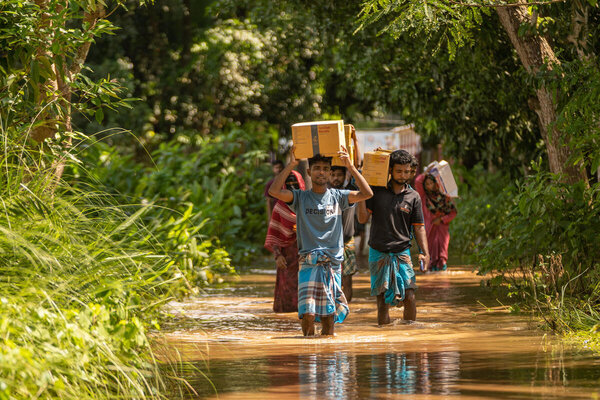As floods hit dozens of countries, WFP urges investment to protect weather-battered communities
The number of floods in WFP’s areas of operation has increased this year, with at least 21 countries already facing significant flooding, and more expected. The floods exacerbate ongoing crises and threaten food security, while also slowing down efforts to deliver critical relief. In 2023, climate extremes drove 72 million people into crisis or emergency levels of hunger, a 26 percent increase from the previous year.
“Rich and poor countries alike are suffering severe floods and record-breaking storms, and with each passing year extreme climate events are becoming the new normal,” said WFP Assistant Executive Director Valerie Guarnieri. “When flood events come on top of conflict, displacement and hunger, they multiply the strain on communities and governments. Investing in early action and preparedness is essential to protect people’s access to food and this is a core priority for WFP.”
In 2023, WFP assisted almost 18 million people in 60 countries with solutions and services to manage climate risks. WFP’s support for early warning systems and ‘anticipatory action’ – where help arrives before disaster strikes - reached 36 countries, covering over 4.1 million people. WFP-supported climate risk insurance programmes provided 5.1 million people in 27 countries with financial protection.
In flood-affected Bangladesh, WFP recently provided cash assistance to 120,000 families before floods hit - one of WFP’s largest anticipatory action programmes to date. WFP has also been supporting cash-for-work schemes that help rebuild critical infrastructure. From Bangladesh to Somalia, WFP is working with governments and communities to analyse climate risks, strengthen early warning systems and expand climate protection.
“Climate shocks are predictable. By investing in preparedness, we can help reduce the impact of extreme weather and safeguard food security amid the climate crisis,” said Guarnieri. Evidence generated by WFP in Bangladesh and Nepal shows that anticipatory action investments have reduced the cost of humanitarian responses to floods in affected areas by up to 50 percent.
The recent spate of floods worldwide has seen WFP responding on several fronts, most recently in Asia and West Africa.
- In Myanmar, WFP is gearing up to expand its flood response operations to also reach those affected by Yagi, one of the strongest typhoons to hit Southeast Asia in decades.
- In Laos, WFP teams are on the ground helping the government and partners assess needs and, over the coming days, 100 metric tonnes of rice will be distributed to affected families.
- Chad, Cameroon, Mali, Niger, and Nigeria have been among the hardest hit in some of the worst flooding Western and Central Africa have ever experienced, with more than four million people have been affected. WFP is ramping up its support, targeting a million people across the region - distributing food and cash. WFP is also advocating for expanded anticipatory action and improvements to early warning systems to help respond more effectively.
- In war-torn Sudan, the worst floods in 40 years are adding to the misery caused by the war. WFP has provided food assistance to 41,000 people affected by the flooding and continues operations to assist those affected by the conflict. But floods are complicating the delivery of lifesaving aid.
- In South Sudan, massive flooding is affecting over 735,000 people, most of whom already face extremely high levels of food insecurity. WFP has been planning for a worst-case scenario and initially plans to reach 1.2 million people from mid-September. The flooding is also creating challenges for WFP's logistics operations, with a sharp increase in airdrops as many communities have become inaccessible.
Forecasts suggest major flooding events will likely continue across Asia, the Sahel, Sudan and South Sudan over the next few months. As La Niña takes over from El Niño, floods and increased tropical storm activity are more likely in Southern Africa, northern South America and Southeast Asia. In addition to the La Niña pattern, the current extremely warm ocean temperatures are fuelling what is expected to be an exceptionally active 2024 hurricane season in the Caribbean.
For photos, click here.
# # #
The United Nations World Food Programme is the world’s largest humanitarian organization saving lives in emergencies and using food assistance to build a pathway to peace, stability and prosperity for people recovering from conflict, disasters and the impact of climate change.
Follow us on X, formerly Twitter, via @wfp_media




